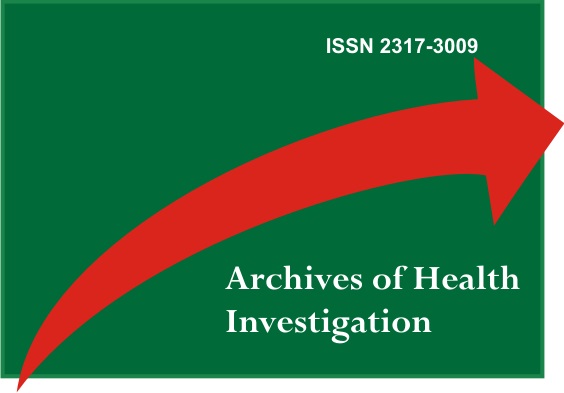A Classificação do Queratocisto Odontogênico: Revisão de Literatura
DOI:
https://doi.org/10.21270/archi.v11i3.5813Palavras-chave:
Cistos Odontogênicos, Organização Mundial da Saúde, Neoplasias de Cabeça e PescoçoResumo
Objetivo: Identificar as alterações feitas na terminologia do queratocisto odontogênico desde as reuniões de 1992 a 2017 e justificar os motivos que o levaram a nova classificação na 4° edição dos tumores de cabeça e pescoço. Medotologia: o trabalho baseia – se em uma revisão de literatura feito na busca nas bases de dados, sendo Pubmed, Scielo, Biblioteca Virtual de Saúde, com os descritores “odontogenic keratocyst” e “classification of head and neck neoplasia”. Os critérios de inclusão foram estudos que tiveram como resultado levantamento sobre o queratocisto odontogênico e a nova classificação. Resultados e discussão: Os resultados revelam quais motivos levaram a Organização Mundial da Saúde (OMS) em reclassificar a patologia, abordando as mutações no gene PTCH que serviram como principal evidência para a alteração da nomenclatura em 2005, o conceito de neoplasia estabelecido pelos dicionários médicos e a comparação desta com o queratocisto odontogênico. Considerações finais: As alterações realizadas na atual classificação concentram – se em simplificar a versão anterior e facilitar a nomenclatura das lesões, tornando-as menos complexas, e auxiliando na condução do caso em termos de diagnóstico. A modificação da nomenclatura do tumor odontogênico queratocístico para queratocisto odontogênico se justifica pela falta de evidências para a permanência dessa patologia como um tumor odontogênico.
Downloads
Referências
Shear M, Speight PM. Cistos da região oral e maxilofacial. 4.ed. Oxford: Blackwell-Munksgaar; 2007.
Aciole GTS, Santos MAM, Acioli JMS, Ribeiro Neto M, Pinheiro ALB. Recurrent odontogenic keratocyst tumor: conservative or radical surgical treatment? a clinical case report. Rev. cir traumatol buco-maxilo-fac. 2010;10(1).
Soluk-Tekkeşin M, Wright JM. The World Health Organization classification of odontogenic lesions: a summary of the changes of the 2017 (4th) edition. Turk Patoloji Derg, 2018;34(1):1-18.
Kramer IR, Pindborg JJ, Shear M. The WHO histological typing of odontogenic tumours. A commentary on the second edition. Cancer. 1992;70:2988–94
August M, Fachin WC, Troulis MJ, Kaban LB. Dedifferentiation of odontogenic keratocyst epithelium after cyst decompression. J Oral Maxillofac Surg. 2003;61(6):678-83.
Wright JM, Vered M. Update from the 4th edition of the World Health Organization classification of head and neck tumours: odontogenic and maxillofacial bone tumors. Head Neck Pathol. 2017;11(1):,68-77.
Wright JM, Odell EW, Speight PM, Takata T. Odontogenic tumors, WHO 2005: Where do we go from here? Head Neck Pathol. 2014;8:373-82
Chan JKC, El-Naggar AK, Grandis JR, Takata T, Slootweg PJ. WHO Classification of Head and Neck Tumours. World Health Organization, 4th edition; 2017.
Qu J, Yu F, Hong Y, Guo Y, Sun L, Li X et al. Underestimated PTCH1 mutation rate in sporadic keratocystic odontogenic tumors. Oral Oncol. 2015;51(1):40-5.
Pavelić B, Levanat S, Crnić I, Kobler P, Anić I, Manojlović S, Šutalo J. PTCH gene altered in dentigerous cysts. J Oral Pathol Med. 2001;30(9):569-76.
Agaram NP, Collins BM, Barnes L, Lomago D, Aldeeb D, Swalsky P et al. Molecular analysis to demonstrate that odontogenic keratocysts are neoplastic. Arch Pathol Lab Med. 2004;128(3):313-17.
Wushou A, Zhao YJ, Shao ZM. A marsupialização é a abordagem de tratamento ideal para tumor odontogênico ceratocístico. J Craniomaxillofac Surg. 2014;42(7):1540-44.
Wakolbinger R, Beck-Mannagetta J. Long-term results after treatment of extensive odontogenic cysts of the jaws: a review. Clin Oral Investig. 2016;20(1):15-22.
Diniz MG, Galvao CF, Macedo PS, Gomes CC, Gomez RS. Evidence of loss of heterozygosity of the PTCH gene in orthokeratinized odontogenic cyst. J Oral Pathol Med. 2011;40:277-80


